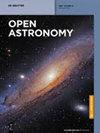Stability of granular media impacts morphological characteristics under different impact conditions
IF 0.5
4区 物理与天体物理
Q4 ASTRONOMY & ASTROPHYSICS
引用次数: 0
Abstract
In planetary surfaces, oblique impact events are commonplace, and their study holds significant importance for understanding planetary impact processes and aiding in the design of landers and impactors. Current research predominantly focuses on simplified models to study the force and motion under vertical impact craters in terms of scale and impact loading. For oblique impacts, investigations have primarily concentrated on the final crater shape. However, the specific influence of impact load motion on particle bed movement and the precise impact angle’s effect on the ultimate crater shape during the impact process remain unclear. In this study, we used a custom-built oblique impact experimental setup to analyze changes in the velocity field of the particle bed and the horizontal movement of the impact load. Using quasi-static region to assess ellipticity, we aimed to reveal the state of particle movement during oblique impacts and explore the impact of impact angles and energies on crater formation. The results indicate that under large impact angles, the obliquely acquired kinetic energy is minimal, leading to a predominant static point source movement of the particle bed. At higher energy levels, the impact load primarily excavates downward, resulting in the formation of circular impact craters. These findings underscore the sensitivity of particle bed motion to impact angles, making it a crucial metric for assessing the impact of oblique angles on final crater morphology.不同冲击条件下颗粒介质冲击形态特征的稳定性
在行星表面,斜向撞击事件司空见惯,研究这些事件对于了解行星撞击过程以及帮助设计着陆器和撞击器具有重要意义。目前的研究主要集中在简化模型上,以研究垂直撞击坑在规模和撞击负荷方面的作用力和运动。对于斜撞击,研究主要集中在最终撞击坑的形状上。然而,冲击载荷运动对颗粒床运动的具体影响,以及在冲击过程中精确的冲击角度对最终弹坑形状的影响仍不清楚。在本研究中,我们使用定制的斜面冲击实验装置来分析颗粒床速度场的变化和冲击载荷的水平运动。利用准静态区域评估椭圆度,我们旨在揭示斜撞击过程中颗粒的运动状态,并探索撞击角度和能量对陨石坑形成的影响。结果表明,在较大的撞击角度下,斜向获得的动能最小,导致颗粒床的静态点源运动占主导地位。在较高的能量水平下,撞击载荷主要向下挖掘,从而形成圆形撞击坑。这些发现强调了颗粒床运动对撞击角度的敏感性,使其成为评估斜角对最终撞击坑形态影响的重要指标。
本文章由计算机程序翻译,如有差异,请以英文原文为准。
求助全文
约1分钟内获得全文
求助全文
来源期刊

Open Astronomy
Physics and Astronomy-Astronomy and Astrophysics
CiteScore
1.30
自引率
14.30%
发文量
37
审稿时长
16 weeks
期刊介绍:
The journal disseminates research in both observational and theoretical astronomy, astrophysics, solar physics, cosmology, galactic and extragalactic astronomy, high energy particles physics, planetary science, space science and astronomy-related astrobiology, presenting as well the surveys dedicated to astronomical history and education.
 求助内容:
求助内容: 应助结果提醒方式:
应助结果提醒方式:


